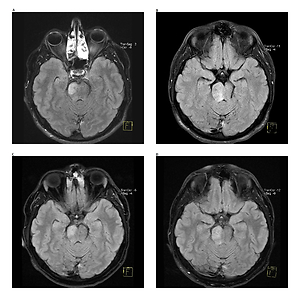CASE REPORT
Glioblastoma mimicking Chronic Lymphocytic Inflammation with Pontine Perivascular Enhancement Responsive to Steroids (CLIPPERS) syndrome – case Report
1
Department of Clinical Oncology and Chemotherapy, Medical University, Lublin, Poland
2
Student Scientific Association, Department of Clinical Oncology and Chemotherapy, Medical University, Lublin, Poland
Corresponding author
Weronika Kuryło
Student Scientific Association, Department of Clinical Oncology and Chemotherapy, Medical University of Lublin, 8 Jaczewski Street, 20-090, Lublin, Poland
Student Scientific Association, Department of Clinical Oncology and Chemotherapy, Medical University of Lublin, 8 Jaczewski Street, 20-090, Lublin, Poland
J Pre Clin Clin Res. 2022;16(3):85-89
KEYWORDS
TOPICS
ABSTRACT
Non-specific focal lesions in the central nervous system pose diagnostic and therapeutic challenges. Moreover, the
prognosis, depending on the lesion etiology, can be extremely varied from mild and potentially curable to extremely
severe and untreatable lesions. Interestingly, due to the lack of a definitive diagnosis, the patient frequently remains in
observation until the disease progresses. This case study presents a patient in whom the radiological image of a non-specific
brainstem lesion was consistent with glioblastoma mimicking Chronic Lymphocytic Inflammation with Pontine Perivascular
Enhancement Responsive to Steroids syndrome (CLIPPERS). Radiologically compatible CLIPPERS may conceal a number
of different pathologies. Reports of CLIPPERS mimickers highlight the importance of considering alternative diagnoses in
patients presenting with the CLIPPERS phenotype. The clinical and radiologic presentation of glioblastoma with features
mimicking CLIPPERS are described.
Szklener K, Kuryło W, Rodzajewska A, Mańdziuk S. Glioblastoma mimicking Chronic Lymphocytic Inflammation with Pontine Perivascular
Enhancement Responsive to Steroids (CLIPPERS) syndrome – case report. J Pre-Clin Clin Res. 2022; 16(3): 85–89. doi: 10.26444/jpccr/154733
REFERENCES (19)
1.
Zalewski NL, Tobin WO. CLIPPERS. Current Neurology and Neuroscience Reports. 2017 Sep;17(9):65. doi: 10.1007/s11910-017-0773-7. PMID: 28726127.
2.
Taieb G, Allou T, Labauge P. Therapeutic Approaches in CLIPPERS. Curr Treat Options Neurol. 2017 May;19(5):17. doi: 10.1007/s11940-017-0455-4.
3.
Pittock SJ, Debruyne J, Krecke KN, et al. Chronic lymphocytic inflammation with pontine perivascular enhancement responsive to steroids (CLIPPERS). Brain. 2010;133(9):2626–2634. doi:10.1093/brain/awq164.
4.
Axelerad A, Stroe A, Mihai C, et al. CLIPPERS, chronic lymphocytic inflammation with pontine perivascular enhancement responsive to steroids: A challenge in neurological practice, clinical landmarks (Review). Exp Ther Med. 2021;22(4):1191. doi:10.3892/etm.2021.10625.
5.
Zalewski NL, Tobin & WO. DEMYELINATING DISORDERS (J BERNARD AND M CAMERON, SECTION EDITORS) CLIPPERS. Published online 1910. doi:10.1007/s11910-017-0773-7.
6.
Zhang L, Zhao D, Li J, et al. A case report of CLIPPERS syndrome and literature review. Medicine (Baltimore). 2021;100(22):e26090. doi:10.1097/MD.0000000000026090.
7.
Vola E, Russo C, Macera A, et al. Unusual CLIPPERS presentation and role of MRI examination in the proper diagnostic assessment: A case report. Eur J Radiol Open. 2019;6:212–214. doi:10.1016/j.ejro.2019.05.005.
8.
Tobin WO, Guo Y, Krecke KN, et al. Diagnostic criteria for chronic lymphocytic inflammation with pontine perivascular enhancement responsive to steroids (CLIPPERS). Brain. 2017;140(9):2415–2425. doi:10.1093/brain/awx200.
9.
Mélé N, Guiraud V, Labauge P, et al. Clinical/Scientific Notes effective antituberculous therapy in a patient with clippers: New Insights Into Clippers Pathogenesis. 2014;1:6. doi:10.1212/NXI.0000000000000006.
10.
Dang YL, Kuan Kok H, Mckelvie PA, et al. Chronic lymphocytic infiltration with pontine perivascular enhancement responsive to steroids (CLIPPERS) and its association with Epstein-Barr Virus (EBV)-related lymphomatoid granulomatosis: a case report. 2021;doi:10.1186/s12883-021-02110-1.
11.
Gul M, Chaudhry AA, Chaudhry AA, et al. Atypical presentation of CLIPPERS syndrome: A new entity in the differential diagnosis of central nervous system rheumatologic diseases. J Clin Rheumatol. 2015;21(3):144–148. doi:10.1097/RHU.0000000000000238.
12.
Berzero G, Taieb G, Marignier R, et al. CLIPPERS mimickers: relapsing brainstem encephalitis associated with anti-MOG antibodies. Eur J Neurol. 2018;25(2):e16-e17. doi:10.1111/ene.13483.
13.
Rauschenbach L, Kebir S, Radbruch A, et al. Challenging Implications of Chronic Lymphocytic Inflammation with Pontine Perivascular Enhancement Responsive to Steroids Syndrome with an Atypical Presentation: Report of Two Cases. World Neurosurg. 2020;143:507–512.e1. doi:10.1016/j.wneu.2020.07.123.
14.
Taieb G, Mulero P, Psimaras D, et al. CLIPPERS and its mimics: evaluation of new criteria for the diagnosis of CLIPPERS. J Neurol Neurosurg Psychiatry. 2019;90(9):1027–1038. doi:10.1136/jnnp-2018-318957.
15.
Galazky I, Büntjen L, Voges J, et al. Brain biopsy in patients with CLIPPERS syndrome: why and when. Ther Adv Neurol Disord. 2022;15:175628642110628. doi:10.1177/17562864211062821.
16.
Ge N, Julien L, Oana P, et al. Brain biopsy is required in steroid-resistant patients with chronic lymphocytic inflammation with pontine perivascular enhancement responsive to steroids (CLIPPERS). 2011; doi:10.1007/s11060-011-0724-0.
17.
Taieb G, Duflos C, Renard D, et al. Long-term outcomes of CLIPPERS (Chronic Lymphocytic Inflammation with Pontine Perivascular Enhancement Responsive to Steroids) in a consecutive series of 12 patients. Arch Neurol. 2012;69(7):847–855. doi:10.1001/archneurol.2012.122.
18.
Ellul MA, Benjamin L, Singh B, et al. Neurological associations of COVID-19. Lancet Neurol. 2020;19(9):767–783. doi:10.1016/S1474-4422(20)30221-0.
19.
Wang L, Holthaus EA, Jimenez XF, et al. MRI evolution of CLIPPERS syndrome following herpes zoster infection. J Neurol Sci. 2015;348(1–2):277–278. doi:10.1016/j.jns.2014.11.022.
We process personal data collected when visiting the website. The function of obtaining information about users and their behavior is carried out by voluntarily entered information in forms and saving cookies in end devices. Data, including cookies, are used to provide services, improve the user experience and to analyze the traffic in accordance with the Privacy policy. Data are also collected and processed by Google Analytics tool (more).
You can change cookies settings in your browser. Restricted use of cookies in the browser configuration may affect some functionalities of the website.
You can change cookies settings in your browser. Restricted use of cookies in the browser configuration may affect some functionalities of the website.


